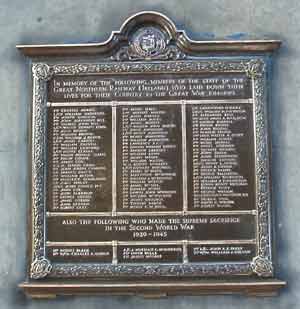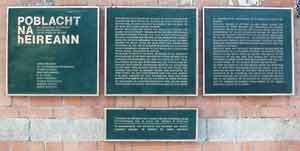Battle Station

The first plaque (above) commemorates members of the staff of the Great Northern Railway who "laid down their lives for their country in the Great War, 1914-1919", or who "made the supreme sacrifice in the Second World War, 1939-1945". What is now Connolly station was then Amiens St., and was the Dublin terminus of the GNR. The country referred to in the upper part of the inscription was Ireland, which was then, as part of the UK, a combatant in WWI.

The second plaque (above) reproduces the 1916 proclamation, evoking the rising of that year and, presumably, also commemorating James Connolly after whom the station is named.
Both plaques commemorate events which were significant in the formation and evolution of the Irish State, and evoke some of the ambiguities of the time. In the eyes of the then prevailing legal system the 1916 participants were seen as traitors, while in republican eyes many of those who signed up in the Great War for Civilisation would have merited the same epithet. Many of the promises of both events remain unfulfilled to this day, and some of those who have not learned from history are still busy repeating it.
Nevertheless, my point is really in the juxtaposition (below) of the two plaques which represent two mainstream traditions in this country. It's nice to see a bit of maturity manifesting itself. Where would Dublin Castle be without it?
